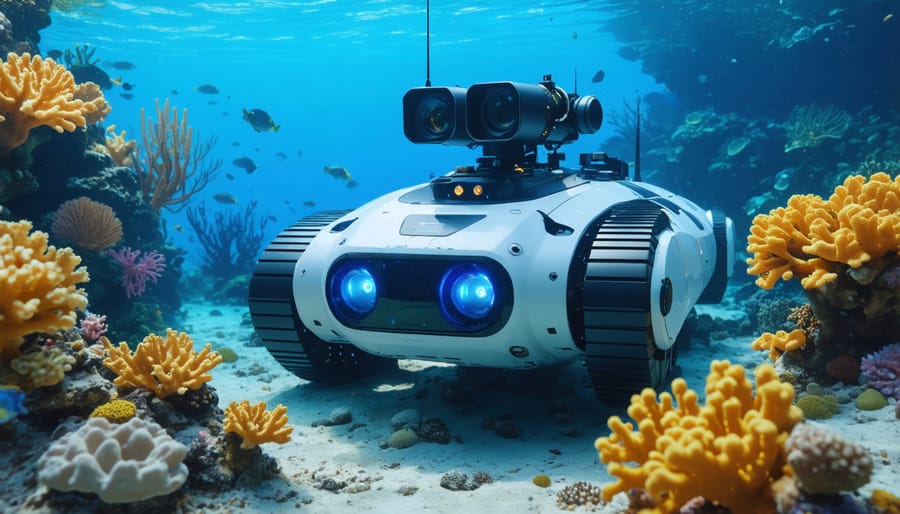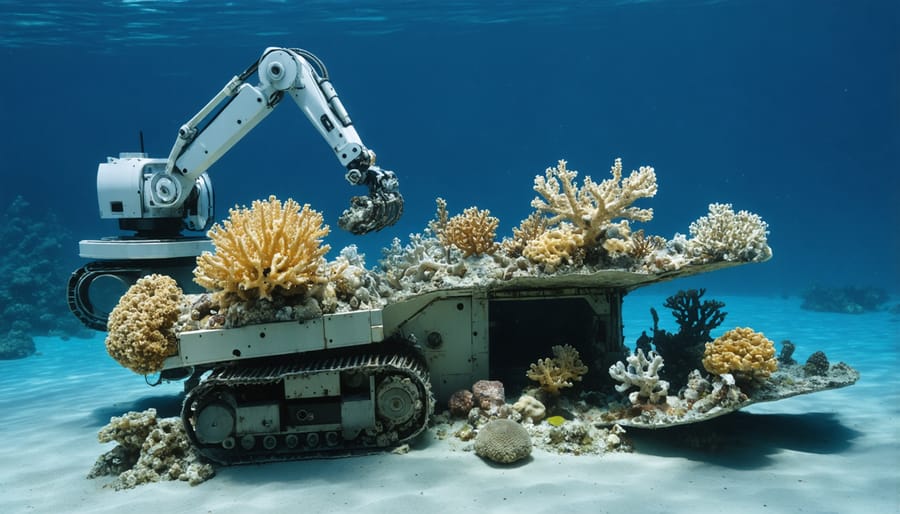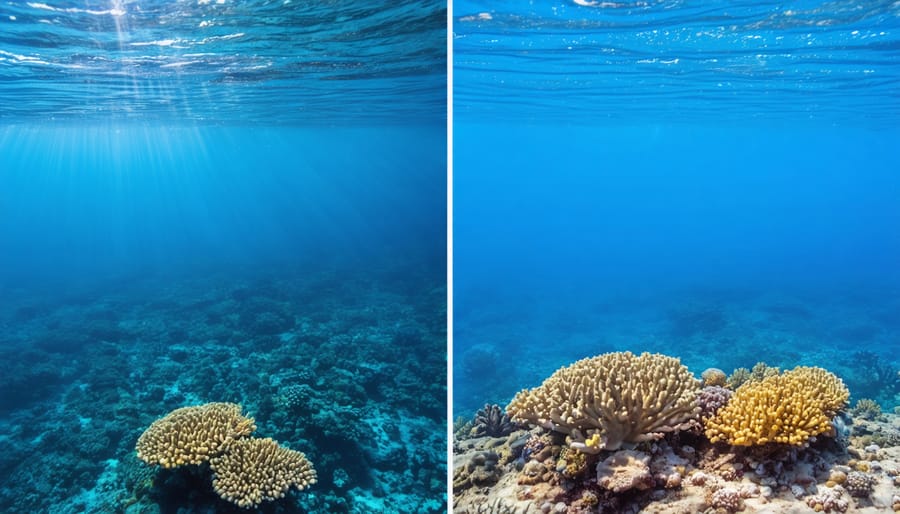
In the depths of our oceans, a technological revolution is silently unfolding as underwater robots emerge as powerful allies in marine conservation. These sophisticated machines, ranging from autonomous underwater vehicles (AUVs) to remotely operated vehicles (ROVs), are transforming how we understand, protect, and restore marine ecosystems. Operating in environments too hostile or deep for human divers, these aquatic robots navigate through coral reefs, explore hydrothermal vents, and monitor marine life with unprecedented precision.
Recent breakthroughs in underwater robotics have enabled scientists to discover new species, map previously uncharted ocean floors, and implement innovative restoration techniques for damaged marine habitats. These robots, equipped with advanced sensors, high-definition cameras, and articulated arms, serve as our eyes and hands beneath the waves, collecting vital data about ocean health while actively participating in conservation efforts.
As climate change and human activities continue to threaten marine biodiversity, underwater robots represent a beacon of hope, offering solutions that combine cutting-edge technology with environmental stewardship. From replanting coral fragments to removing marine debris, these mechanical guardians are proving instrumental in our quest to preserve and regenerate the ocean’s delicate ecosystems for future generations.
The Evolution of Marine Restoration Robotics
From ROVs to Autonomous Systems
The journey of underwater robotics began in the 1950s with the first Remotely Operated Vehicles (ROVs), initially developed for military and industrial purposes. These tethered systems, controlled from the surface, revolutionized our ability to explore deep ocean environments. The 1960s saw ROVs being adopted by the offshore oil and gas industry, leading to significant technological improvements in underwater manipulation and imaging capabilities.
By the 1980s, scientists began adapting ROVs for marine research, adding sophisticated sensors and sampling tools. This decade also marked the emergence of early Autonomous Underwater Vehicles (AUVs), which could operate without direct human control. The 1990s brought major advances in battery technology and navigation systems, enabling longer missions and more precise operations.
The 2000s ushered in a new era of intelligent underwater systems, featuring advanced AI algorithms and improved communication capabilities. Today’s autonomous systems can perform complex tasks like coral reef monitoring, species identification, and environmental sampling with minimal human intervention. The latest developments include swarm robotics and bio-inspired designs that mimic marine creatures, promising even greater possibilities for ocean exploration and conservation.
Current State of Marine Restoration Robots
Today’s marine restoration robots represent a remarkable fusion of advanced technology and environmental stewardship. These underwater machines range from small autonomous units that plant coral fragments to larger systems capable of removing marine debris and invasive species. Modern restoration robots typically feature HD cameras, advanced sensors, and AI-powered navigation systems that allow them to work efficiently in challenging underwater environments.
Recent innovations include robots equipped with specialized grippers that can handle delicate marine organisms without causing damage, and swarm systems that work together to restore larger reef areas. Some models now incorporate machine learning algorithms that help them identify different species and adapt their restoration techniques accordingly.
The latest generation of these robots can operate at depths of up to 100 meters and stay underwater for extended periods, making them invaluable for restoration projects in areas difficult for human divers to access. They’re also becoming more energy-efficient, with some units powered by solar charging stations or utilizing advanced battery technologies that extend their operational time.
While these robots continue to evolve, they’re already making significant contributions to marine ecosystem restoration efforts worldwide, working alongside human conservationists to protect and rebuild our ocean’s precious habitats.

Key Applications in Ecosystem Restoration
Coral Reef Rehabilitation
Underwater robots are revolutionizing coral reef rehabilitation efforts, offering innovative solutions to protect and restore these vital marine ecosystems. These sophisticated machines assist marine biologists in various aspects of reef reconstruction, from coral propagation to habitat monitoring.
One of the primary applications involves robots designed for coral fragmentation and transplantation. These devices carefully cut healthy coral fragments and attach them to degraded reef areas using eco-friendly materials. The precision and efficiency of these robots allow for larger-scale restoration projects than traditional manual methods.
Advanced robotic systems equipped with AI-powered cameras monitor coral growth rates and health indicators, providing real-time data to conservation teams. This continuous surveillance helps identify potential threats and assess the success of rehabilitation efforts. Some robots even use specialized arms to remove invasive species and marine debris that threaten reef health.
Recent innovations include autonomous underwater vehicles (AUVs) that distribute coral larvae to strategic locations, enhancing natural reef recovery processes. These robots can work at depths and conditions that would be challenging for human divers, expanding the reach of restoration efforts.
The integration of these robotic solutions with traditional conservation methods has shown promising results. For instance, the Great Barrier Reef’s LarvalBot project demonstrated how robots could distribute millions of coral larvae across damaged reef areas, significantly accelerating natural recovery processes.

Seagrass Meadow Restoration
Innovative robotic systems are revolutionizing seagrass meadow restoration efforts, offering new hope for these vital marine ecosystems. These underwater robots combine precision planting techniques with advanced monitoring capabilities to enhance the success rate of restoration projects.
The latest generation of seagrass restoration robots uses AI-powered navigation and specialized planting mechanisms to carefully embed seagrass shoots into the seafloor. These machines can work continuously in conditions that would be challenging for human divers, significantly accelerating the restoration process. Some models can plant up to 2,000 shoots per hour while using sustainable restoration materials to anchor new growth.
Advanced sensing technologies enable these robots to monitor water quality, light penetration, and sediment conditions in real-time. This data helps scientists optimize planting patterns and timing, leading to higher survival rates for transplanted seagrass. The robots also track the growth and health of restored meadows through regular surveillance, using machine learning algorithms to identify potential threats early.
Marine biologist Dr. Sarah Chen, who leads restoration projects in the Pacific Northwest, notes: “These robots have transformed our ability to restore seagrass meadows at scale. What once took our team months can now be accomplished in weeks, with greater precision and monitoring capabilities.”
The integration of underwater robotics with restoration efforts represents a significant step forward in marine conservation, offering hope for the recovery of these essential habitats that support marine biodiversity and help combat climate change.
Marine Debris Removal
Underwater robots are revolutionizing marine debris removal efforts, offering efficient and sustainable solutions to ocean pollution. These automated systems combine advanced sensors, AI-powered detection algorithms, and specialized collection mechanisms to identify and retrieve various types of marine waste, from microplastics to abandoned fishing gear.
The most widely deployed systems use a combination of cameras and sonar technology to scan the ocean floor and water column, creating detailed maps of debris locations. Machine learning algorithms help these robots distinguish between marine life and various types of waste, ensuring safe and precise collection operations.
Notable examples include the WasteShark, an autonomous surface vessel that mimics whale sharks’ feeding patterns to collect floating debris, and the Guardian LF1, a deep-sea robot capable of removing larger items like ghost nets from ocean depths. These systems can operate continuously for extended periods, significantly increasing the efficiency of cleanup operations.
Recent innovations have introduced robots equipped with sorting mechanisms that can categorize collected waste for recycling purposes. Some models even feature onboard processing units that can compact plastic waste, making transportation to shore more efficient.
The impact of these robotic systems has been remarkable. In pilot programs across various marine environments, automated cleanup systems have shown the ability to collect up to 500 kilograms of marine debris daily, operating with minimal human intervention and reduced environmental impact compared to traditional cleanup methods.
Success Stories and Real-World Impact
Great Barrier Reef Project
The Great Barrier Reef has become a testing ground for innovative underwater robotic solutions in marine conservation. In 2020, researchers launched an ambitious project focusing on rebuilding marine habitats through automated restoration techniques. The project deploys a fleet of autonomous underwater vehicles (AUVs) equipped with specialized coral-planting mechanisms and monitoring systems.
These robots, nicknamed “LarvalBots,” have successfully distributed over 800,000 microscopic coral larvae across damaged reef areas. Using computer vision and AI-driven navigation, the robots identify optimal locations for coral settlement, increasing survival rates by up to 45% compared to traditional restoration methods.
The project has also introduced innovative “RangerBots” that patrol the reef, detecting and controlling crown-of-thorns starfish populations, a major threat to coral ecosystems. These robots can operate continuously for up to eight hours, covering significantly more area than human divers.
Early results show promising signs of reef recovery in treated areas. Monitoring data indicates a 20% increase in coral coverage where robots have been deployed, with particularly strong growth in fast-growing Acropora species. The success of this large-scale robotic intervention has inspired similar projects worldwide, demonstrating how technology can accelerate ecosystem restoration efforts when combined with traditional conservation approaches.

Mediterranean Seagrass Initiative
The Mediterranean Seagrass Initiative has emerged as a pioneering program showcasing the successful integration of underwater robotics in marine ecosystem restoration. Since its launch in 2019, the initiative has successfully replanted over 20,000 square meters of Posidonia oceanica seagrass beds along the Spanish and Italian coastlines.
Using autonomous underwater vehicles equipped with precision planting tools, the program has achieved a remarkable 78% survival rate for transplanted seagrass—significantly higher than traditional manual planting methods. These robots, operating at depths between 10 and 30 meters, can work continuously in conditions that would be challenging for human divers.
The initiative’s most notable achievement has been the restoration of a crucial seagrass meadow near the Balearic Islands, where robotic systems planted 5,000 seedlings in just two weeks. This restored area now serves as a nursery for various fish species and has shown a 40% increase in local marine biodiversity.
Data collected by the robots has also provided valuable insights into seagrass growth patterns and optimal planting conditions. Temperature sensors, current monitors, and water quality analyzers help scientists identify the most suitable locations for restoration efforts, leading to better resource allocation and higher success rates.
The program’s success has inspired similar initiatives across the Mediterranean basin, with Greece and Tunisia launching their own robotic seagrass restoration projects in 2022.
Future Prospects and Challenges
Emerging Technologies
Recent breakthroughs in underwater robotics are revolutionizing marine habitat restoration efforts. Advanced AI-powered robots now feature enhanced computer vision systems that can identify and classify coral species with remarkable accuracy. These smart machines use machine learning algorithms to adapt their restoration techniques based on local conditions and species requirements.
Innovative developments include soft robotics technology, allowing robots to handle delicate marine organisms without causing damage. These flexible manipulators mimic the gentle movements of sea creatures, enabling more precise and careful restoration work. Breakthrough propulsion systems, inspired by fish locomotion, help robots navigate complex reef structures while minimizing environmental impact.
Scientists are also developing swarm robotics capabilities, where multiple smaller robots work together cooperatively. These robot teams can cover larger areas more efficiently and tackle complex restoration tasks that single units cannot manage alone. Additionally, new biodegradable materials are being integrated into robot design, ensuring that any parts that may become detached naturally decompose without harming marine life.
The latest power systems utilize renewable energy sources, including wave and solar power, allowing for extended underwater operations without the need for frequent battery replacements.
Addressing Current Limitations
Despite significant advancements in underwater robotics, several challenges remain to be addressed. Battery life continues to be a major limitation, with most autonomous underwater vehicles (AUVs) operating for only 8-12 hours before requiring recharging. Scientists are exploring new power solutions, including solar-powered charging stations and wireless underwater charging systems.
Communication underwater presents another significant hurdle, as radio waves don’t travel well through water. Current research focuses on developing more reliable acoustic communication systems and optical wireless networks that can transmit data more efficiently in underwater environments.
Navigation accuracy in deep-water environments remains challenging due to GPS limitations underwater. Teams are working on improved inertial navigation systems and developing AI-powered algorithms that can better process visual and sonar data for more precise positioning.
Cost remains a barrier to widespread adoption, particularly for smaller research organizations and conservation groups. However, emerging technologies and manufacturing processes are gradually making underwater robotics more accessible, with some organizations developing modular, cost-effective designs that can be adapted for different missions.
As we reflect on the remarkable advancements in underwater robotics, it becomes clear that these technological innovations are more than just scientific achievements – they represent hope for our oceans’ future. These robotic interventions have revolutionized our ability to study, protect, and restore marine ecosystems, offering solutions to challenges that once seemed insurmountable.
The success stories we’ve witnessed, from coral reef restoration to deep-sea exploration, demonstrate the vital role underwater robots play in marine conservation. These mechanical allies allow us to extend our reach beneath the waves, gathering crucial data and performing delicate restoration work with unprecedented precision.
However, technology alone cannot save our oceans. The future of marine conservation depends on collective action and sustained support from communities worldwide. Whether you’re a student, scientist, or concerned citizen, there are numerous ways to contribute to marine conservation efforts. Consider supporting organizations that utilize underwater robotics for conservation, participating in citizen science projects, or advocating for policies that protect marine ecosystems.
Educational institutions and research centers are increasingly offering opportunities for hands-on experience with marine robotics. By engaging with these programs, we can help cultivate the next generation of marine technologists and conservationists who will continue to innovate and protect our ocean environments.
The time to act is now. As we face unprecedented environmental challenges, underwater robotics provides us with powerful tools to make a difference. Together, we can support and advance these technological solutions while working toward a healthier, more resilient marine ecosystem for future generations.
jessica
Ava Singh is an environmental writer and marine sustainability advocate with a deep commitment to protecting the world's oceans and coastal communities. With a background in environmental policy and a passion for storytelling, Ava brings complex topics to life through clear, engaging content that educates and empowers readers. At the Marine Biodiversity & Sustainability Learning Center, Ava focuses on sharing impactful stories about community engagement, policy innovations, and conservation strategies. Her writing bridges the gap between science and the public, encouraging people to take part in preserving marine biodiversity. When she’s not writing, Ava collaborates with local initiatives to promote eco-conscious living and sustainable development, ensuring her work makes a difference both on the page and in the real world.
